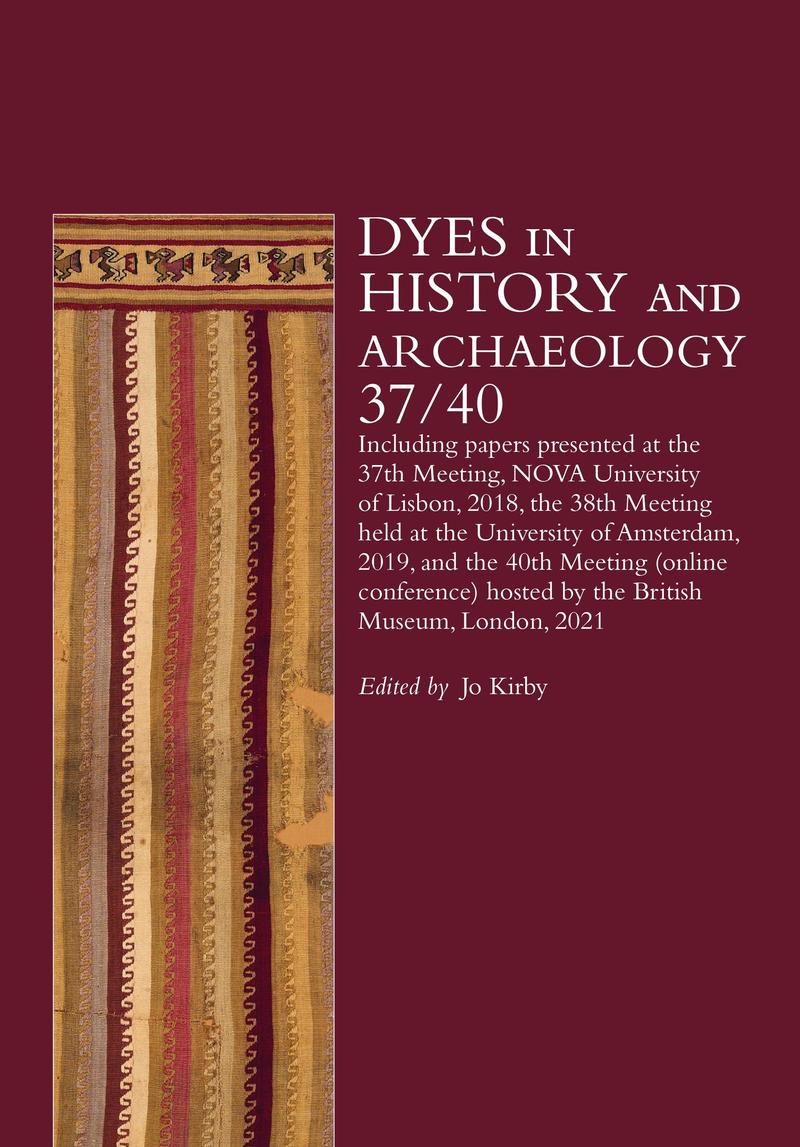Deep in the past, in South America and Mesopotamia, textile fibres were being given colour, purple and red, to make them attractive and interesting and to give pleasure to those who wore them. Many centuries later, South America was the source of a bright and unusual blue, Maya blue, used in painting, but this too is associated with a more complicated, more varied story.
An important element of the story is that if the technology of dyeing in 18th-century London with, for example, madder is examined, it is not so far away from the work of the dyer in Mesopotamia centuries earlier. However, the 18th century was the time of wonderfully colourful and exuberant fabrics and tapestries. A century and a half later, a new age of brilliantly coloured synthetic dyes, the likes of which had never been seen before, exploded onto the scene with hundreds of colours with exotic names and doubtful permanence. However, some old dyes were still used on an industrial scale: lichen purples and browns, unassuming and still widely traded, were used throughout the 19th century.
These and other stories will take the reader from the earliest times, a glimmer of colour in the distant past, to the very real conservation problems of deteriorating containers of early synthetic dyes – a long and colourful history.
The topics covered in this edition vary from the dyes of South America, Mesopotamia, Austria, 17th - 19th Century Flanders and England to the use of lichen, lac and redwood lake as pigments and cochineal for paints and inks.
These papers were presented at the 37th, 38th and 40th meetings of the DHA group at NOVA Universityof Lisbon (2018), the University of Amsterdam (2019) and the online conference hosted by the BritishMuseum, London (2021)
Editorial
Foreword
The Color Purple in the Andes
Elena Phipps
Maya Blue: Painting from the Past in the Present
Laura Osorio Sunnucks, Lorena Ancona, Joanne Dyer and Luis May
Evidence of the Use of a Dye Chemically Related to Commelinin in Mesoamerican Codices
David Buti, Chiara Grazia, Fabien Pottier, Anne Michelin, Christine Andraud, Virginia M. Lladó-Buisán,Davide Domenici, Aldo Romani, Antonio Sgamellotti and Costanza Miliani
Dyes in Archaeological and Historical Contexts from the Atacama Desert (South America): An Overview
Marcela Sepúlveda
Ingenious Crafts: Tricks, Tips and Techniques for Dyeing Wool in Ancient Mesopotamia (c.2000–500 bce)
Shiyanthi Thavapalan
Methodology and Reconstruction of Three Recipes to Dye Terneyt, Feuillemorte and Lyfverve from Conste des ververs, a Flemish Dyeing Manuscript from Leuven, 1619–1623
Natalia Ortega Saez, Sophie Kirkpatrick and André Verhecken
A 19th-century Dyer’s Notebook
Susan Kay-Williams
The Tinctorial Properties of Lichens: The Work of William Lauder Lindsay (1829–1880) and his Collection of Dyed Fabric Samples
Vanessa Habib
Historical and Scientific Investigation into the Transition from Madder to Synthetic Alizarin Dyes in French Uniforms (Pantalon Garance)
Marie-Anne Sarda and Mohamed Dallel
Dye-house Notes from the Crutchley Archive, 1716 to 1728: Detailed Descriptions of the Five Stages of ‘Grain’ Dyeing for Red Colours on Woven Wool Fabrics
Anita Quye, Dominique Cardon and Jenny Balfour-Paul
The Psychedelic World of Textile Dyes in Spitalfields: The V&A Leman Silk
Lucia Burgio, Clare Browne and Maarten R. van Bommel
Lightfastness of Blue Indigo in 18th-century French Tapestries
Hortense De La Codre, Christian Aupetit, Rémy Chapoulie, Laurent Servant and Aurélie Mounier
The Zötl Family: A Tradition of Dyeing in Austria
Regina Hofmann-de Keijzer, Matthijs de Keijzer, Alfred Atteneder, Robert Kralofsky, Art Néss Proaño Gaibor and Ineke Joosten
Recipes, Colorants, Carpets: The Use of Natural Dyestuffs by a mid-Victorian English Carpet Manufacturer
Laura Maccarelli and Terry T. Schaeffer
The Use of Lac in Medieval Islamic Manuscripts and Manuscripts Made in Islamic Lands
Cheryl Porter
Reconstruction of Persian Dyes used in Manuscripts based on Traditional Recipes and Development of a Spectral Database by Non-invasive Analytical Techniques
Mojtaba Mahmoudi Khorandi, Maurizio Aceto, Monica Gulmini, Oliver Hahn, Samanehalsadat Ehteram, Angela Benotto and Angelo Agostino
Vordan Karmir: An Attempt to Unravel the Mystery of Armenian Cochineal Recipes for Paints and Inks used in Manuscripts
Hermine Grigoryan, Armen Sahakyan and Maria J. Melo
Tannins and the Dyeing of Silk: The Effects on Pigments Made from Silk Extracts
David Peggie and Jo Kirby
Lakes on a Large Scale: The Production of Redwood Lake Pigments in the 19th-century Paint Industry
Eva Eis
What is Bruzuļkoks? A Study of a Dyewood Found on the Coast of the Baltic Sea
Anete Karlsone and Valda Valkovska
Visible-induced Spectrofluorimetry as a Non-invasive Tool for the In Situ Identification of Natural Dyes in Historical Textiles
Silvia Bruni, Margherita Longoni, Silvia De Meo, Francesca Beatrice Scalzo, Angela Dibenedetto and Vittoria Guglielmi
Bright Orange and Scarlet Red: Disclosing the Composition and Degradation Mechanisms of ‘Combined Lake’ Formulations
Francesca Sabatini, Eva Eis, Francesca Magini, Ilaria Degano and Thomas Rickert
Conserving the Rainbow: First Approaches towards the Preservation of the Dye Collection of the Hochschule Niederrhein
Marc Holly, Christoph Herm and Jürgen Schram
